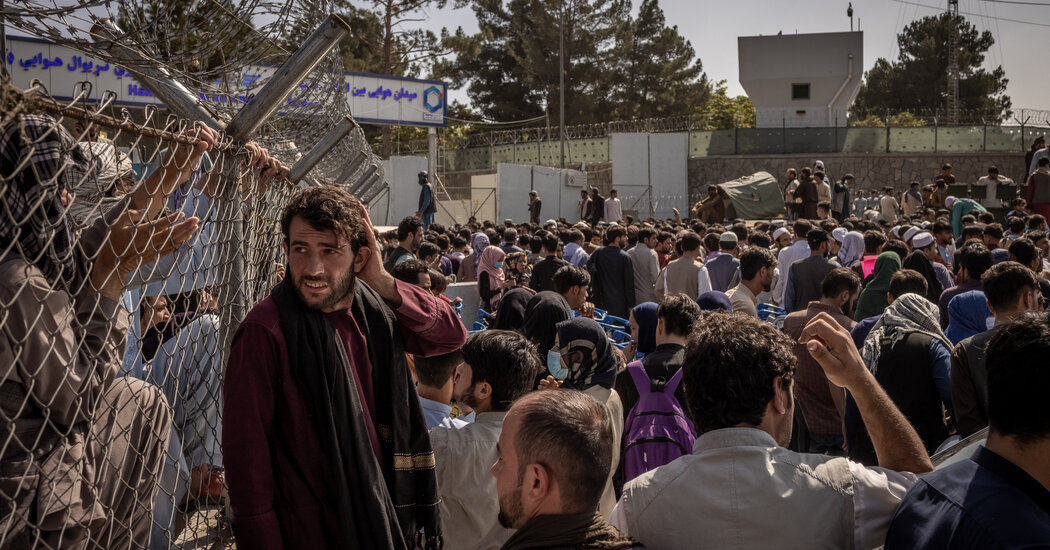
Evacuations Continue as Taliban Reassert ‘Islamic Emirate of Afghanistan’


As the Taliban celebrated the anniversary of the nation’s independence from Britain more than a century ago, they reaffirmed an “Islamic Emirate of Afghanistan” on Thursday, even as tens of thousands sought flee the country.
The declaration, tweeted by the group’s spokesman, Zabihullah Mujahid, is the moniker the Taliban has used for its insurgency and harkens back to when the group ruled Afghanistan from 1996 to 2001.
Worried about a return to that brutal era, thousands have been trying to flee the Taliban takeover. Crowds continued to camp out near Kabul’s airport on Thursday, while U.S. troops tried to quell the chaos and accelerate the evacuation flights.
The mammoth evacuation effort gathered pace, with Afghan refugees and international repatriates landing in Europe, Qatar, the United Arab Emirates and elsewhere.
A Spanish military plane landed before dawn at Torrejon air base outside Madrid, one of three aircraft that the Spanish defense ministry has sent to evacuate citizens and Afghans who worked with the Spanish government, along with their families.
Afghan refugees who arrived in Germany, some cradling children, described harrowing scenes outside the airport in Kabul, the Afghan capital, where Taliban soldiers have blocked the entrances and beat back crowds by firing rifles and occasionally hitting people with sticks and hoses.
Australia has evacuated dozens of its citizens and Afghans to a military base in the United Arab Emirates, where they were awaiting flights to Australia, Prime Minister Scott Morrison said on Thursday. Amid criticism that military flights were departing Kabul mostly empty — the first Australian plane carried just 26 passengers on Wednesday — Mr. Morrison insisted that the government was moving “as quickly as we can.”
The troubled evacuation has become a symbol of the confusion and uncertainty of the first days of the Taliban’s return to power, as throngs of Afghan civilians try to flee the country despite the group’s pledges to rule without violence.
The evacuation effort also represents a test of the U.S. withdrawal plans, which call for the country’s troops to stay in Afghanistan only as long as is needed to bring Americans and some Afghan allies home, likely stranding many who want to leave because they fear Taliban attacks.
The road to the airport has been particularly dangerous, with Taliban patrolling checkpoints. Just after 7 a.m., a Taliban fighter stood on a concrete barricade, holding a radio and a handgun in the same hand and shouting. Taxis inched forward along a road lined with abandoned cars.
An Afghan British family waited in the crowd, a mother and daughter wearing black chadors and head scarves, and two sons standing next to suitcases. The young woman said that the Taliban were calling people by country, but that each call prompted a rush of would-be refugees to the front.
Some families waited in taxis. Others got out to walk. Parents carried small children, and a man pounded on the back of a van to keep it from backing into his mother, whom he pushed in a wheelchair.
Image
The Pentagon, which has deployed 5,000 U.S. troops to secure the airport, said that it had asked the Taliban to allow safe passage for American citizens, but that it did not have the ability to go out and fetch people from Kabul or other cities.
Officials said that the U.S. military had evacuated approximately 5,000 people, and that those numbers would increase as U.S. personnel processed about 500 people per hour at the airport gates.
“The Taliban are in and around Kabul right now, but they are not interfering with our operations,” Gen. Mark Milley, the chairman of the Joint Chiefs of Staff, told a news conference at the Pentagon.
On Wednesday, The New York Times said that 128 current and former Afghan employees and family members had reached safety. Michael Slackman, an assistant managing editor, said that the group had “kept their heads during some very scary moments” and asked employees to “help all of these families make the transition to new lives abroad.”
But many Afghans who have managed to flee the country have left loved ones behind, unable to secure visas for those who are not immediate family members or to get them to the airport in time for departing flights.
Earlier this week, outside a housing complex in eastern Maryland, a former contractor for the United States who was relocated from Jalalabad in eastern Afghanistan said that he had arrived safely with his wife and five children, but that his parents and sisters remained behind. He had lost all contact with them since he departed Afghanistan less than two weeks ago.
“I’m very happy here,” said the man, who asked to be identified only as Masoon out of fear for his safety, “but I am not happy about my family.”
“The Taliban is in Jalalabad, and what can I do about that situation?” he added. “It is really a dangerous thing.”

WASHINGTON — President Biden said on Wednesday that the United States was committed to evacuating every American out of Afghanistan, even if that may mean extending the military mission beyond his Aug. 31 deadline for a total withdrawal.
“If there’s American citizens left, we’re going to stay to get them all out,” Mr. Biden said during an interview on ABC News.
“So Americans should understand that troops might have to be there beyond Aug. 31?” asked the interviewer, George Stephanopoulos.
“No,” Mr. Biden replied. “Americans should understand that we’re going to try to get it done before Aug. 31.” But he then said, “If we don’t, we’ll determine at the time who’s left.”
Mr. Biden, as he did earlier in the week, offered a strong defense of his administration’s handling of the military withdrawal, which has plunged Afghanistan into chaos.
“The idea that somehow there’s a way to have gotten out without chaos ensuing — I don’t know how that happens,” he said, according to a transcript provided by the network.
Mr. Stephanopoulos asked Mr. Biden whether in making the decision to withdraw forces from America’s 20-year war in Afghanistan he had “priced in” the risk that United States citizens and Afghan allies would struggle to evacuate the country, putting them in danger from Taliban forces who might try to exact revenge.
The president initially answered “yes,” and then added: “Now exactly what happened, I’ve not priced in.”
In the days since Kabul fell to the Taliban on Sunday, thousands of Americans and Afghans have surged toward the airport, seeking flights out of the country. Taliban forces outside the airport have been brutally stopping many people at checkpoints. Many others have made it to the airport perimeter only to be turned away.
Mr. Biden insisted in the interview that the Taliban had agreed to let U.S. citizens get through to the airport.
“Look, one of the things we didn’t know is what the Taliban would do in terms of trying to keep people from getting out,” he said. “What they would do. What are they doing now? They’re cooperating, letting American citizens get out, American personnel get out, embassies get out, et cetera.”
That was not the case, he acknowledged, for the thousands of Afghans who helped U.S. and NATO forces over the years and now have a target on their back.
“They’re having — we’re having some more difficulty having those who helped us when we were in there,” the president said.
The president insisted that the administration had acted swiftly to evacuate the American Embassy in Kabul without losing any lives.
And though the world has looked on in horror, he appeared dismissive of the images of United States military planes taking off with Afghans clinging to their sides. Some plunged to their deaths.
“That was four days ago, five days ago!” Mr. Biden said.
Mr. Stephanopoulos asked whether what happened was a “failure of intelligence, planning, execution or judgment,” deflected to the broader issue of his decision to end the war.
“Look, it was a simple choice, George,” Mr. Biden said. “When you had the government of Afghanistan, the leader of that government, get in a plane and taking off and going to another country, when you saw the significant collapse of the Afghan troops we had trained, up to 300,000 of them, just leaving their equipment and taking off — that was, you know, I’m not, that’s what happened.”

Some members of an Afghan girls’ robotics team that captured international attention have arrived in Qatar, the group says, joining a growing number of people fleeing the Taliban’s takeover of Afghanistan.
Members of the team left Kabul on a commercial flight on Tuesday and will remain in Qatar to continue their education, according to a statement on Wednesday by the team’s founder, the Afghan tech entrepreneur Roya Mahboob.
Other girls on the robotics team, Afghanistan’s first, planned to remain in the country, where Ms. Mahboob acknowledged that they face a worrying future under the Taliban. The hard-line Islamist movement barred girls from attending school when it last ruled Afghanistan, from 1996 to 2001, and although its leaders say they will allow greater freedoms, many Afghans are skeptical.
“The Taliban have promised to allow girls to be educated to whatever extent allowed by Shariah law,” Ms. Mahboob said. “We will have to wait and see to what that means.”
“Obviously, we hope that women and girls will be allowed to purse dreams and opportunities under the Taliban,” she said, “because that is what is best for Afghanistan and in fact the world.”
Members of the team left their hometown, Herat, in western Afghanistan, as the Taliban seized territory across the country last week. They were scheduled to fly out of Kabul on Monday, but amid chaos at the airport, including Afghans crowding the runway and even clambering onto the fuselage of departing planes, their flight and others were canceled.
The team won hearts worldwide in 2017, when six members were denied visas to travel to the United States for a robotics competition, only to be allowed in eventually after a public outcry, a congressional petition and intervention by President Donald J. Trump.
They traveled back and forth between Afghanistan and competitions in North America and Europe for several months until their visas expired, amassing trophies and social media followers.
In 2019, when the Taliban and the United States were working to negotiate a peace agreement, one of the team members, Kawsar Roshan, told The New York Times that a future in which the Taliban denied her an education “would be unbelievable for me.”

Taliban militants are intensifying a search for people they believe worked with U.S. and NATO forces, including among the crowds of Afghans at Kabul’s airport, and have threatened to kill or arrest their family members if they cannot find them, according to a confidential United Nations document.
The document, from a U.N. threat-assessment adviser, directly contradicted the militant group’s public assurances that it would not seek revenge on members and supporters of the toppled government.
There were multiple reports that the Taliban had a list of people they wanted to question and punish — and their locations, the document said.
Already, the document said, the Taliban had been going door to door and “arresting and/or threatening to kill or arrest family members of target individuals unless they surrender themselves to the Taliban.”
The document, dated Wednesday, was provided to the United Nations by the Norwegian Center for Global Analyses, a group that provides intelligence information to agencies of the global organization. It was shared internally at the United Nations and seen by The New York Times.
Members of the Afghan military and the police, as well as people who worked for investigative units of the toppled government, were particularly at risk, the document said.
It contained a reproduced letter dated Aug. 16 from the Taliban to an unnamed counterterrorism official in Afghanistan who had worked with U.S. and British officials and then gone into hiding before the insurgents came to the official’s apartment.
The letter instructed the official to report to the Military and Intelligence Commission of the Islamic Emirate of Afghanistan in Kabul. If not, it warned, the official’s family members “will be treated based on Shariah law.”
The Taliban have repeatedly issued assurances that they will not use their victory to wreak revenge on people who opposed them. The report adds to the growing doubts about that pledge, and suggests that the Taliban may indeed engage in reprisal killings, as they did when they took over in Afghanistan more than 20 years ago.
On Wednesday, a public display of dissent in the northeastern city of Jalalabad was met by force. Taliban soldiers fired into the crowd and beat protesters and journalists.

World Health Organization officials warned on Wednesday that the Taliban takeover of Afghanistan was impeding efforts to address the coronavirus pandemic and other dire health crises there.
Gauging the spread of the coronavirus in Afghanistan has always been difficult because of a lack of testing. The average daily number of reported new cases peaked in late June at more than 2,000 and has since fallen sharply, according to the Our World in Data project at the University of Oxford. But it is likely that the figures do not reflect the actual spread of the virus.
Afghanistan’s vaccination efforts have struggled since they began in the spring, harassed by corruption, limited public health resources and widespread public skepticism. According to Our World in Data, less than 2 percent of Afghanistan’s population has been vaccinated.
“In the midst of a pandemic, we’re extremely concerned by the large displacement of people and increasing cases of diarrhea, malnutrition, high blood pressure, probable cases of Covid-19 and reproductive health complications,” Dr. Tedros Adhanom Ghebreyesus, the W.H.O.’s director general, said at a news conference.
He said that agency staff members were still in Afghanistan and were “committed to delivering health services to the most vulnerable.”
Many Afghans are vulnerable to diseases like polio, which has been eradicated in most of the world but is still endemic there. Fourteen million Afghans are suffering from hunger, United Nations officials said on Wednesday.
Aid groups are struggling to provide humanitarian assistance inside Afghanistan and to the tens of thousands of refugees a week who are fleeing to neighboring countries. Refugee camps, with their crowded and often unsanitary conditions, can become incubators for the virus, though many camps have fared better than experts initially feared they would.
U.N. officials said that their agencies in Afghanistan were in contact with the Taliban in an effort to coordinate aid and immunizations. Caroline Van Buren, a representative of the U.N. High Commissioner for Refugees, said that the Taliban had so far provided protection for all of the refugee agency’s offices in the country.
At the same time, though, the Taliban have resumed some of the practices common when they held power 20 years ago. Ms. Van Buren said that officials had received reports of women being prohibited from going to work, and, in some areas, barred from leaving their homes without being accompanied by a close male relative.
Video

A group of Afghan leaders are trying to rally a force to resist the Taliban from the same strategic valley that two decades ago held out against the militants — and provided U.S. spies and special forces operators a launchpad for the invasion that drove the Taliban from power in the months after the Sept. 11, 2001, attacks.
Yet the parallels with that earlier fight in a pocket north of Kabul known as the Panjshir Valley, however intriguing, are limited, and even Afghans sympathetic to the effort expressed deep doubts about its prospects.
Unlike 20 years ago, the resistance leaders do not control the territory they would need to open a supply line through Afghanistan’s northern borders, nor do they appear to have any significant international support.
How many men and how well supplied they are are also open questions. Former Afghan officials put the number of fighters holed up in Panjshir at 2,000 to 2,500, and they are said to have little beyond assault weapons.
And the leaders, while well-established Afghan political and military figures, lack the charisma and military prowess of the man who led the old Northern Alliance that resisted the Taliban in the 1990s, Ahmad Shah Massoud. He was killed by assassins from Al Qaeda two days before the Sept. 11 attacks and is now a mythic figure among the ethnic Tajiks who populate northern Afghanistan and who made up the bulk of those who first fought Taliban rule.
For now, the leaders of the movement insist that their goal is to negotiate a peace deal with the Taliban on behalf of the now-defunct Afghan government, said Amrullah Saleh, one of the men organizing the resistance.
Mr. Saleh was Afghanistan’s first vice president until Sunday, when President Ashraf Ghani fled Kabul ahead of the Taliban’s advance into the city, and he is now claiming to be the “caretaker president” under Afghanistan’s U.S.-brokered 2004 Constitution.
“We have lost territory but not legitimacy,” Mr. Saleh said in an interview conducted over text message. “I, as caretaker president, upholder of the Constitution, don’t see the Taliban emirate either as legitimate or national.”
Mr. Saleh has been joined in Panjshir by Ahmad Massoud, the son of the assassinated resistance leader, and Gen. Yasin Zia, a former Afghan army chief of staff and deputy defense minister.
Afghanistan will have “peace and stability,” said Mohammad Zahir Aghbar, an Afghan ambassador to Tajikistan aligned with the holdouts in the Panjshir Valley, “if the Taliban who are in Doha and Pakistan agree to a settlement accepting what the world is asking for.”
Mr. Saleh said the group believed “in a genuine peace process, which doesn’t exist at the moment.”
“Should the Taliban be ready for meaningful discussions, we will welcome it,” he said. “If they insist on military conquest, than they better read Afghan history.”
The Panjshir Valley features prominently in that history.
The deep and narrow gorge at the valley’s mouth was tailor-made for obstruction and ambush, and the valley held out not only against the Taliban in the 1990s, but also the Soviets in the 1980s. The first Americans to enter Afghanistan in September 2001, a small C.I.A. team, went to Panjshir to secure the Northern Alliance as allies.
Mr. Saleh said he had survived “two attacks and one ambush” by Taliban fighters as he drove to Panjshir on Sunday.
Mr. Saleh, who also previously ran Afghanistan’s spy service, the National Directorate of Security, was cagey about what size force was in Panjshir, saying that he did not want “compromise our military secrets or operational security.”
“But we are on the top of the situation and organizing things,” he said, adding that his team was in touch with other Afghan leaders who fought the Taliban 20 years ago, though he would not name them.
Still, it was far from clear what outside help might arrive or whether Mr. Saleh’s claim to continuity of government under the Afghan Constitution would gain traction.
At least one place has bought in: the Afghan Embassy in Tajikistan. In the carpeted meeting rooms of the building, off a dusty, taxi-clogged street in Dushanbe, Mr. Ghani’s photographs have come down, and Mr. Saleh’s have gone up.
Source: https://www.nytimes.com/live/2021/08/19/world/taliban-afghanistan-news/

















